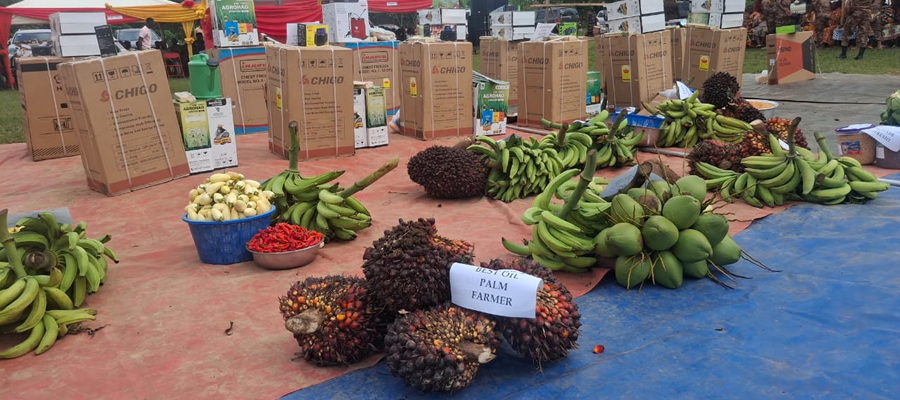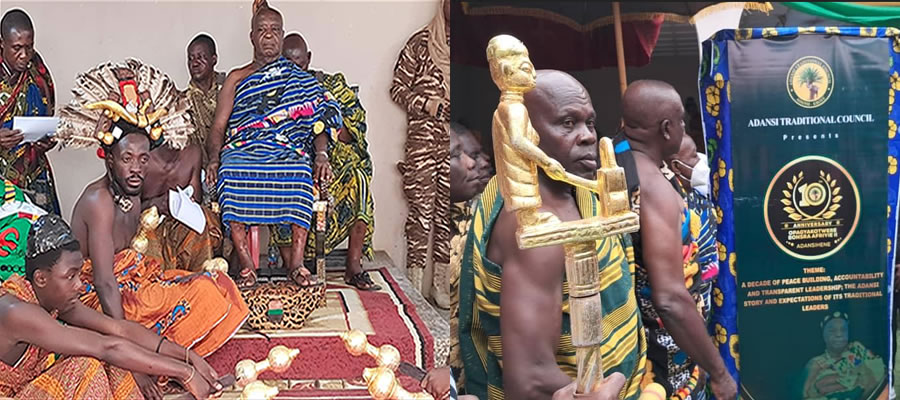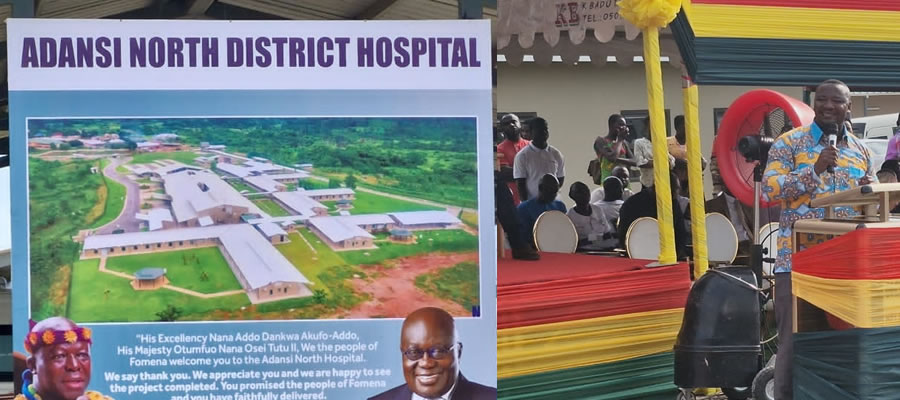

DISTRICT ECONOMY
THE STRUCTURE OF THE LOCAL ECONOMY
a) Primary Production: The District Economy is predominantly an agrarian one with 77%
of the inhabitants being farmers majority of whom engaged in subsistence farming in crop production and live stock keeping.
b) Services: Services also employ about 15% of the people in the district. Some of the main component of the services provided include, buying and selling, tourism, banking, communication, dressmaking, hairdressing, operation of private schools etc.
c) Manufacturing: Manufacturing employs about 8% of the working population in the district. Some of the manufacturing activities include production of T & G, extraction of palm oil and palm kennel, processing of cassava into gari, etc. These activities are scattered throughout the district. This also includes mining and quarrying.
HOUSEHOLD INCOME AND EXPENDITURE
On the whole, household incomes in the district are very low. This is reflected in the fact that the output of the people who are mainly subsistence farmers, small scale manufacturers and limited services providers are very low and do not bring sufficient incomes to the various households in the district.
As a result of this, low standard of living of the people is reflected in the lives of the people. The evidence of which is found in the dilapidated buildings that the majority of the people occupy, the inability of majority of the people to send their children to good schools due to their inability to pay school fees, leading to high school dropout rate in the district, inability of majority of household to afford balanced diets, etc.
B A N K I N G
In recent past, the Banking industry in Ghana has witnessed a lot of transformation which include the introduction of electronic banking among others into the industry. Despite the fact that running and maintaining such facilities are very expensive, banks keep investing more resources into this area even in time of recession.
In the wake of this development, some of the banks are still operating with the manual system; thus making it difficult to provide better services. The District has a Rural Bank with branches in Fomena, Akrokerri and a mobilization centre at Asokwa – Adansi. As stated above the bank has not introduced any form of technology in its operations thereby making their services very unattractive as a result of the following:
i) Human errors in the course of processing customer information is high, making customers
loose interest in transacting business with the bank.
ii) Retrieval of information is cumbersome and time consuming, sometimes resulting into formation of long queues in the banking hall.
iii) There is the problem of accessibility as the bank and its branches are not many making it difficult for all to access.
iv) The system puts a lot of stress and strain on the employees of the bank and in the end making them ineffective.
v) Cost involved in terms of labour and paper work is high.
In spite of the above problems associated with their operations, it has economically impacted positively on the lives of the people in the district, by way of giving loans to womengroups and other small scale business enterprises in the district.
The bank is highly patronized during the Cocoa seasons and at the end of every month by the few salaried workers in the district.
Non-banking and informal financial institutions such as Susu collectors and money lenders are also prevalent in the district. These non-banking institutions are well patronized due to their easy access and personal touch, despite the high interest rates charged by
the operators.
Although the bank’s services are highly patronized, they are faced with the problem of office accommodation, accessibility and retrieval of information because they are not computerized.
THE WAY FORWARD
The bank has already acquired land and also cut sod for the construction of permanent office complex in Fomena, the district capital. The bank also has plans for computerizing and networking all their branches as soon as work on the office complex is completed.
REVENUE AND EXPENDITURE STATUS
Generally, the revenue that comes to the district is very low. Some of the revenue is internally generated while the rest is obtained from external sources.
The revenue items that are generated from internal sources include the following;
- Rates
- Lands
- Fees and Fines
- Licenses
- Rent
- Investment
- Mineral royalties
- Miscellaneous receipts
The revenue items that are received from external sources also include the following;
- District Assemblies Common Fund
- District Development Facility
- Rural Water Supply Projects
- HIPC Fund
- Community Based Rural Development Fund
- M – SHAP Fund – AIDS Commission
In 2006 the actual revenue generated by the Assembly was GH¢271,650.28. In 2007 the Assembly projected for an amount of GH¢1,321,295.00 but was able to generate about GH¢1,328,152.00whichis100.5 %. A more proactive method was adopted in 2008 and the Assembly was able to realize GH¢1,879,979.33that was 102.8 % of the estimated revenue of GH¢1,827,969.76 for 2008. However, in 2009 an estimated revenue of GH¢3,476,922.58onlyGH¢1,036,127.15wascollected.
Improving IGF through Participatory Budgeting Process
Participatory Budgeting is the involvement of all citizens in the budgeting process, from the fixing of rates, fees and fines to the projections of revenue and expenditures through to budget implementation, monitoring and evaluation. The Assembly, within the plan period 2010-2013 will use this strategy to improve revenue collection.
Financial Management Practices
Disbursement of funds, both IGF and External Inflows is done in accordance with laid down financial regulations and guidelines. The Assembly strictly adheres to current financial regulations namely the Local Government Act 1993, Act 462, the Public Procurement Act, 2003, Act 663, the Financial Administration Act, 2003, Act 654 and the Internal Audit Agency Act, 2003, Act 658. These legislations provide general direction in terms of policy and control mechanism of revenue and expenditure.
The Assembly’s Procurement Process
Section 17 (1) of the Public Procurement Act, 2003 (Act 663) states that “ Each procurement entity shall establish a Tender Committee in the manner set out in Schedule 1” The District Assembly as a procurement entity has established a District Tender Committee and is performing its functions as preserved in the Act.
Again, Section 20 (1) of Act 663 calls for the establishment at each level of public procurement Tender Review Committees. The Assembly in complying with the provisions of this Act has established a District Tender Review Committee and currently performing its functions as enshrined in the Act. The Assembly also has a Project Monitoring Team which oversees the supervision of programmes and projects so as to get value for money.
Matching Revenue with Expenditure
The Assembly administers to match actual revenue collected with approved expenditure by:
- Spending within approved budget limits.
- Making sure proper authorization and approval of all payments.
- Monitoring all payment to ensure that they are being made for budgeted programmes and projects.
- Preparation of monthly trial balance and bank reconciliation statements.
- Critically analyzing monthly variances of revenue expenditure to find solutions to improve overall performance in
- revenue collection and expenditures.
The District Assemblies’ Common Fund (DACF)
The District Assemblies’ Common Fund (DACF) was created under section 252 of the Fourth Republican Constitution of 1992 and enacted by Parliament on 6th July, 1993 (Act 455). Under this Act, Parliament is annually required to allocate not less than five percent (5%) of total revenues of Ghana to the District Assemblies for development.
Constraints and Challenges of external sources of funding
· Untimely release of the funds from the Central Government;
· Shortfall in expected share of the DACF;
· Unplanned deductions by the Administrator of the DACF;
· Overreliance on external sources of funding; and
ECONOMIC RESOURCES, INTRA/INTER TRADE
The district is blessed with a very fertile land which is being used for agricultural activities like the cultivation of cash crops example oil palm, cocoa, citrus, teak trees etc. The fertile soil again supports the cultivation of food crops like plantain, cocoyam, cassava, vegetables, etc.
Apart from the fertile soils, there are granitic rocks which outcrop in areas around Dompoase, Akrokerri and Patakro which has already attracted small scale quarrying in the district. However, there is hope that large scale quarrying would very soon spring up in the district.
The district can also boast of both virgin and secondary forest, rich in timber resources which are being extracted for various economic activities. Gold has also been explored in the district, and it is expected that sooner or later gold could be mined in the district to boost its economy.
Both intra and inter trade feature prominently in the district. On intra trade; there is the existence of a major market centre in the district at Fumso which is organized weekly on Thursdays. Farmers and small scale manufacturers in the district take advantage of the market and sell their products in the market.
On inter trade; goods are imported from Kumasi, Obuasi, Bekwai, new Edubiasi, Cape Coast, and other places to Fumso every Thursday for sale while goods produced in the district are exported every Thursday to the various major markets outside the district for sale.
ECONOMICALLY ACTIVE POPULATION
According to the 2010 population census, 48% of the population in the district ie; (15–60 years) constitutes the economically active population. Out of the 48% some of them are either in school or learning some kind of trade, while a sizeable number of them are unemployed or under employed, leaving only a few of them in active employment. The implication is that there is high dependency ratio in the district leaving very little money in the hands of households for savings and investments.
PRUDENT FISCAL MANAGEMENT
For the Assembly to use its resources judiciously, the Assembly is enjoined to follow the laid down rules and regulations, and some cases laid down financial resolutions and guidelines. Some of the financial regulations include; Financial Memoranda (FM), The New Procurement Act 2003, Act 663. Some of the directives also emanate from the office of the District Assemblies’ Common Fund Administrator and the Ministry of Local Government, Rural Development and Environment. The Regional Co-ordinating Councils are also enjoined to ensure that all expenditures in the various districts are in line with laid down procedures.
ALLOCATION OF RESOURCES/FUNDS
The district allocates its resources based on its revenue and expenditure estimates for the year. In doing this, community needs are collated and their urgency thoroughly assessed. This is done to determine which community or sector should be considered for a project.
In the process, all the resources at the disposal of the district are put together against which the community needs are matched. Since the resources are limited, they should be judiciously utilized, and therefore the most pressing demands which when satisfied would serve the majority of the people are selected for execution.
Date Created : 11/10/2017 3:38:20 AM













 facebook
facebook
 twitter
twitter
 Youtube
Youtube
 +233 593 831 280
+233 593 831 280 0800 430 430
0800 430 430 GPS: GE-231-4383
GPS: GE-231-4383 info@ghanadistricts.com
info@ghanadistricts.com Box GP1044, Accra, Ghana
Box GP1044, Accra, Ghana